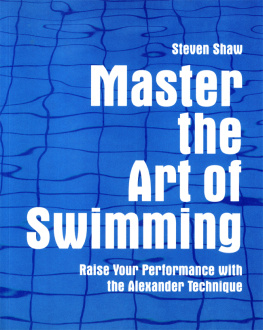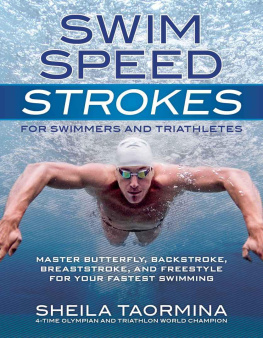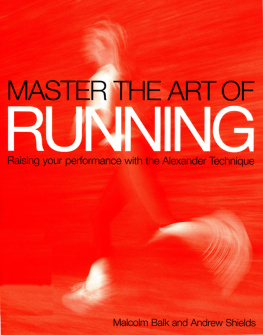Master the Art of Swimming

Steven Shaw
Master the Art of Swimming
Raise Your Performance with the Alexander Technique

CONTENTS
IN PRAISE OF SWIMMING
An open mind, a swimming pool or stretch of calm water and this book are all you need to realize your untapped potential for freedom of movement with the Shaw Method. Prepare to embark on an amazing journey of self-discovery. In the rhythmic movements of swimming, free from the downward pressure of gravity, you can discover the ultimate form of meditation. Swimming is the supreme form of exercise for mind, body and spirit as well as improving flexibility and tone it will also boost your self-esteem and sense of well-being. Whatever challenges you face in life, swimming always helps: when you are stressed it relaxes you, when you are exhausted it revitalizes you, and when your muscles are stiff it releases them. Forget Prozac the remedy is in H20!
Exercise fads come and go, but swimming always remains at the top of the popularity charts. The psychological benefits of immersion, rather than the knowledge that swimming is good for joints and muscles, keep millions of people switched on to swimming. It is an ideal antidote to our pressured lives, offering a rare opportunity to rejuvenate the body while allowing the mind to rest.
The verb to swim is defined as the ability to propel oneself through water, whereas the noun swimming is generally defined as a competitive sport. The competitive perspective is so pervasive that even the Oxford English Dictionary describes swimming purely in terms of being a sport. This attitude is extremely limiting. As long as you gauge your performance in the water by the number of laps you swim or whether you arrive at the end of the pool before the next person, there is little chance of discovering the riches water has to offer.

It is, however, important to acknowledge that a competitive outlook has been vital to the remarkable evolution of swimming. Without the motivation to go faster, human beings would probably still swim like other land-based mammals, using what is essentially a form of walking. Competition has led us to develop four ingenious ways of moving through the water: breaststroke, backstroke, front crawl and butterfly. Mans ability to swim well also derives from certain unique physical characteristics. Only human babies, born with subcutaneous fat, can float and swim from birth. Of all primates, only humans have a descended larynx, allowing us to easily take in air through the mouth when swimming.
What differentiates the approach outlined here from others is that it draws on the Alexander Technique. The Techniques central idea is that the relationship between head, neck and back determines the quality of the bodys overall coordination. When the neck is free and the head balances lightly at the top of the spine we are able to function more efficiently; when it is tense and the vertebrae are compressed our functioning is adversely affected. My years of experience have confirmed that the head-neck-back relationship is of utmost importance and that improving this relationship is the single most significant factor affecting swimming performance.
We are now entering a new phase in the evolution of swimming. This book will help you transcend the competitive mindset and recraft each stroke to promote the optimum use of the self. This approach to swimming is closer to a martial art than a competitive sport winning or losing are mere distractions from an ongoing journey towards self-mastery. Water is an ideal environment for self-development; it amplifies psychophysical patterns, providing the opportunity to become aware of how thoughts affect quality of movement. Swimming is unlike any other physical activity: apart from needing to coordinate the whole body in the horizontal plane, you also have to be in tune with the water. If you try hard and apply too much effort you will flounder; swimming gracefully is more about letting go and going with the flow than it is about pushing yourself.
To the evolved or enlightened swimmer, there are a number of ways of measuring ones performance. Speed is just one indicator, but no more significant than, for example, the distance travelled per stroke or the relative energy expended. A master of swimming never compromises a good body form in the quest for speed hunching the shoulders in breaststroke reduces drag but is unacceptable as it has a detrimental effect on body alignment. This is not to say that swimming in a more mindful way reduces speed; on the contrary with the Shaw Method most people are able to swim considerably faster and further than they ever thought possible. This new approach limits the energy expended on non-propulsive movements, gaining greater purchase on the water and so realizing maximum benefit from precious time in the water.
If you are on the look out for a training manual that provides elaborate tables telling you how far and fast to swim and how much rest to take between each set, look elsewhere. There are countless get fit swimming books and websites that will give you this type of information. If you are looking for something more reflective that encourages you to pause, rethink your relationship with the water and explore each stroke in depth, read on. Instead of mindlessly swimming lap after lap, you will learn to pay attention to the process of swimming and develop the quality of the experience. This learning goes far beyond the pool, providing you with a powerful new model with which to approach any activity.
Taking the plunge into learning the art of swimming may seem somewhat daunting, particularly for those with a more sedentary lifestyle. You may feel self-conscious about your size and the prospect of being seen in public in a swimming costume. However, having decided to embark on a fitness programme it is far better to begin in the pool where the effects of buoyancy significantly reduce the risks of injuring weight-bearing joints. More regular swimmers may feel self conscious about practising new strokes or performing unusual looking practices. Take comfort from the fact only those swimmers straining their necks to keep their faces out of the water will be watching. With any luck your progress will inspire them to join in!
Stevens Story
My earliest memories of swimming are of splashing around in the local open-air lido where I spent much of my leisure time. The pool never seemed to lose its magical appeal. During the summer months, the anticipation was often overwhelming. I have vivid memories of one scorching day, standing impatiently in what was surely the longest queue ever. The interminable wait added to my sense of excitement and I can remember my heart racing when my nose picked up the sweet scent of chlorine. When we finally arrived at the turnstiles, I had to be restrained from running ahead. I always wore my trunks under my trousers to avoid wasting precious time.
Until the age of eight I spent my time at the childrens pool, a large semi-circular construction where water streamed from the mouths of two lion statues. The pool had a gradual, beach-style entrance with sloping sides great fun to run in and out of when the lifeguards werent watching! We picnicked on the grassy banks surrounding the pool and after the compulsory hours wait to ensure digestion we raced back to the pool for more aquatic fun. The lido was much more than a pool: it was a place to hang out with friends and family.










